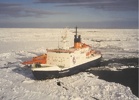 Dr Vincent Gray is one of the most active of NZ’s little band of cranks. He’s been publishing his “envirotruth” newsletter since the ’90s, always brimful of climate scepticism, and has been a stalwart reviewer of IPCC reports. His most recent contribution to the IPCC process was to make 1,898 comments on the final draft of the Working Group One report – 16% of the total, and, perhaps unsurprisingly, he accounted for 95% of the comments rejected by the authors. Vincent’s offerings are the backbone of the NZ Climate “Science” Coalition site, and I always enjoy reading them.
Dr Vincent Gray is one of the most active of NZ’s little band of cranks. He’s been publishing his “envirotruth” newsletter since the ’90s, always brimful of climate scepticism, and has been a stalwart reviewer of IPCC reports. His most recent contribution to the IPCC process was to make 1,898 comments on the final draft of the Working Group One report – 16% of the total, and, perhaps unsurprisingly, he accounted for 95% of the comments rejected by the authors. Vincent’s offerings are the backbone of the NZ Climate “Science” Coalition site, and I always enjoy reading them.
His most recent, Problems With Surface Temperature Data [PDF], is typical. He asserts it’s impossible to arrive at a meaningful figure global temperature, prefers satellite data but doesn’t believe it, and then states that “Since the amalgamated surface record is unreliable, an indication of temperature change over the past century can be obtained from well-maintained local records. Attempts to correct for the many errors, though not entirely successful, give records of some credibility.” (Otherwise known as the cherry-pickers charter). He then disinters a 1994 paper that found a 60-65 year cycle in global temperature (but I thought that was meaningless) if the data is “detrended”. One wonders what trend was removed. Perhaps the long term underlying rise in temperature? If we ignore the data, it goes away. Magical thinking at its finest.
[UPDATE 6/11/07: NASA’s excellent Earth Observatory posts a very interesting article about James Hansen and the development of the global temperature record. There’s a superb animation of atmospheric flows from space on page 2.]
But the most interesting part of Vincent’s report is the note at the end: “This paper is part of “The Science is not Settled: Major Issues Remain Unresolved by the IPCC: A Report of the NIPDD” (sic) (Non-governmental International Panel on Climate Change) to be published by the Science and Environmental Policy Project, Arlington Virginia.” The NIPCC? Seems this is something Fred Singer at SEPP has set up as a counterblast to the IPCC, and its report is due soon. From Fred’s The Week That Was for Sept 1st:
Highlights of the NIPCC Report
- Demonstration of the insignificance of human contribution to current warming – using the ‘fingerprint’ method – and why future anthropogenic warming is negligible
- Why climate models do not agree with observations – the role of feedbacks
- Evidence that solar activity controls most climate change on a decadal time scale
- Evidence that future warming will not accelerate sea level rise appreciably
- No evidence for more storms, hurricanes, droughts, and floods as climate warms
- How we know that a warmer climate is better than a colder one
- Evidence that the Medieval Period was warmer than today
- Evidence that pre-1940 warming was not anthropogenic
- Problems with data quality and special problems with sea surface temperatures
- Uncertainties about the CO2 budget, past and future – and of future emission scenarios
- Changes in ocean heat storage, glacier length, and sea ice coverage indicate climate change – but not whether the cause is anthropogenic or natural
That’s a mind-boggling list. If all the papers show the – how shall I put it politely – “rigorous” approach to the science that Dr Gray demonstrates, the NIPCC report will be a real paradigm shift. Or perhaps not.

 A
A 
